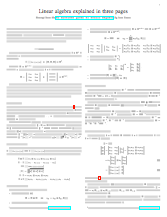I just pushed an update to the Linear algebra explained in four pages tutorial.
Anyone who has an exam with lots of $A\vec{x}=\vec{b}$ stuff on it coming up should check it out because it covers: vector operations, matrix operations, linear transformations(matrix-vector product, fundamental vector spaces, matrix representation), solving systems of linear equations (the RREF stuff), matrix inverse, eigenvalues.
UPDATE: I found another excellent tutorial which I think you should also read, especially if you are a visual person. A Geometric Review of Linear Algebra by Prof. Eero P. Simoncelli (discuss on HN if you are a procrastinating person). If you’re a studious person, you’ll also go to en.wikibooks.org/wiki/Linear_Algebra and practice solving problems. To become a powerful person, don’t look at the solution until you’ve attempted the problem (with pen and paper) for at least five minutes.
UPDATE: I found some other useful short tutorials, like this short review of linear algebra from Stanford and another one from Boulder which both cover interesting details and bring a new perspective.

Karl
December 10, 2013 — 7:04 pm
As someone who has never done linear algebra, I got lost pretty quickly.
It starts in section B with the big E thing. I don’t know what that means, or why the a and b have subscripts ik and kj when before they were both ij. Or what k is. Actually, I’m not really sure what i and j are, either. I guessed that they were column numbers or something.
I don’t know what inverse, transpose, trace, or determinant mean.
In section C, the matrix notation for R is different, with (a11,a12) in it. What does the comma do? What does [:,1] mean?
By section D my head is spinning, so I skipped ahead.
I could sort of follow along in section III for a bit. At the end of page 2 you list out a bunch of things that are supposed to be equivalent (I think?) but I’m not sure what the funny “1” thing is, or why that multiplied by x is equal to the final answer.
In section B, what are the three types of row operations that correspond with the three types of elementary matrices?
I don’t understand where you got the values for the E1A. None of the matrices have the same numbers as the elementary matrices.
At this point I’m too far lost to follow any further.
A. Reader
December 10, 2013 — 10:40 pm
Karl: I don’t think this is meant as a replacement for a textbook…
Rafael
December 10, 2013 — 11:52 pm
Context: I bought your book at the full price yesterday. I support what you are doing and hope to see you succeed.
I think this need at least another page. The biggest problem is that it doesn’t define a lot of the terms that it introduces or explain the significance of those new terms. Lot’s of what but no why.
Further, your lack of ‘BS’ doesn’t equip the reader to effectively consult a ‘BS’ source for the explanation on what you left out.
Here are the questions that crossed my mind as I read it:
1. Is a one row matrix a vector? If not, why? What’s a natural/common occurrence of either?
2. Why don’t you cite any example of problems in science, business or technology that can be described in terms of vectors or matrices?
3. Why would I/When would I/What happens when I — add/ subtract/ scale/ norm/ dot product/cross product a vector. I think that seeing these tools with no context for their use, left me ill equipped to fit them within any schema. I immediately switched into memorization mode. I would give you extra points if you used one consistent example and showed how to vectors that represented easily understood concepts were changed through these operations.
4. Why do we care about the angle between vectors? Does this mean that vectors have shape and that the shape is influenced by the the numbers within the vector?
I then lightly skimmed until I got to section III which sounded like it might provide the skeleton on which I could go back and hang the stuff I just skimmed over but I quickly lost hope that it would that. I was still focused on trying to dissect the relationship between vectors and their angles.
I look forward to a future version of this and would encourage you to target standardized test taking adults, college seniors and high schoolers for 4.0. Tons of people need a good algebra review.
geek42
December 11, 2013 — 12:43 am
why many authors like to use two column layout for pdf that would read on PC?
Markus
December 11, 2013 — 5:24 am
Hi Geek42,
I think it’s because the tow-column layout is much more eye-friendly to read 🙂 (thants also the reasng to have column-layouts in papers and magazines).
cheers
A. Nother
December 11, 2013 — 5:29 am
@A. Reader: but it kind of claims to be one…
ivan
December 11, 2013 — 11:28 am
@Karl and @Rafael Thank you for the feedback, which is extremely useful. We take indices ij, and notation like ∃, ϵ, for granted. This is the very BS that I would like to avoid so as to make the tutorial accessible for more readers.
In particular the idea of using a “running example” throughout the sections is excellent. I will only need to explain the real-world context once and I can keep referring to it.